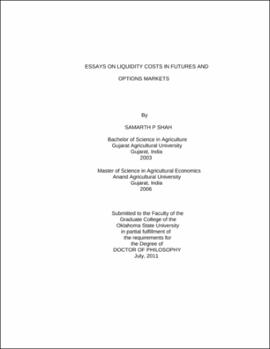| dc.contributor.advisor | Brorsen, B. Wade | |
| dc.contributor.author | Shah, Samarth P. | |
| dc.date.accessioned | 2013-11-26T08:22:05Z | |
| dc.date.available | 2013-11-26T08:22:05Z | |
| dc.date.issued | 2011-07 | |
| dc.identifier.uri | https://hdl.handle.net/11244/6539 | |
| dc.description.abstract | Scope and Method of Study: | |
| dc.description.abstract | The study comprises three essays about the market microstructure of futures and options markets with the main emphasis on liquidity costs. The first essay determines the impact of the transition to electronic trading at the Kansas City Board of Trade (KCBT) wheat futures market. In this essay liquidity costs are estimated for side-by-side trading of open outcry and electronic wheat futures market at KCBT using intraday transaction prices. Factors such as daily volume, volume per trade, volatility and price clustering are used to explain the difference in liquidity costs in the two markets. The second essay attempts to guide the choice problem that agricultural producers face when selecting between futures and options markets to hedge their cash market position. Liquidity costs in KCBT wheat options and futures market are estimated and a new measure of liquidity costs in options markets is proposed. The third essay deals with the liquidity costs of stock and stock index futures and option markets at National Stock Exchange (NSE) of India. The liquidity costs are estimated using the new measure as well as several other measures previously developed in the literature. | |
| dc.description.abstract | Findings and Conclusions: The main findings of the first essay are that the electronic wheat futures market has lower liquidity costs for all but the largest traders at KCBT. The key to continued existence of the open outcry market appears to be its ability to handle large orders. The second essay concludes that although, option contracts are often suggested to agricultural producers as an alternative to futures contracts to avoid margin calls, it costs more to trade an option. Regardless of the measure used, the liquidity costs in options markets were at least three times higher compared to the futures markets. A similar difference is found between the liquidity costs in stock and stock index futures and option markets at NSE, India in the third essay. The difference is more prominent in stock index futures and options compared to the individual stock futures and options. | |
| dc.format | application/pdf | |
| dc.language | en_US | |
| dc.rights | Copyright is held by the author who has granted the Oklahoma State University Library the non-exclusive right to share this material in its institutional repository. Contact Digital Library Services at lib-dls@okstate.edu or 405-744-9161 for the permission policy on the use, reproduction or distribution of this material. | |
| dc.title | Essays on liquidity costs in futures and options markets | |
| dc.contributor.committeeMember | Anderson, Kim B. | |
| dc.contributor.committeeMember | Norwood, F. Bailey | |
| dc.contributor.committeeMember | Krehbiel, Timothy L. | |
| osu.filename | Shah_okstate_0664D_11484 | |
| osu.accesstype | Open Access | |
| dc.type.genre | Dissertation | |
| dc.type.material | Text | |
| thesis.degree.discipline | Agricultural Economics | |
| thesis.degree.grantor | Oklahoma State University | |
